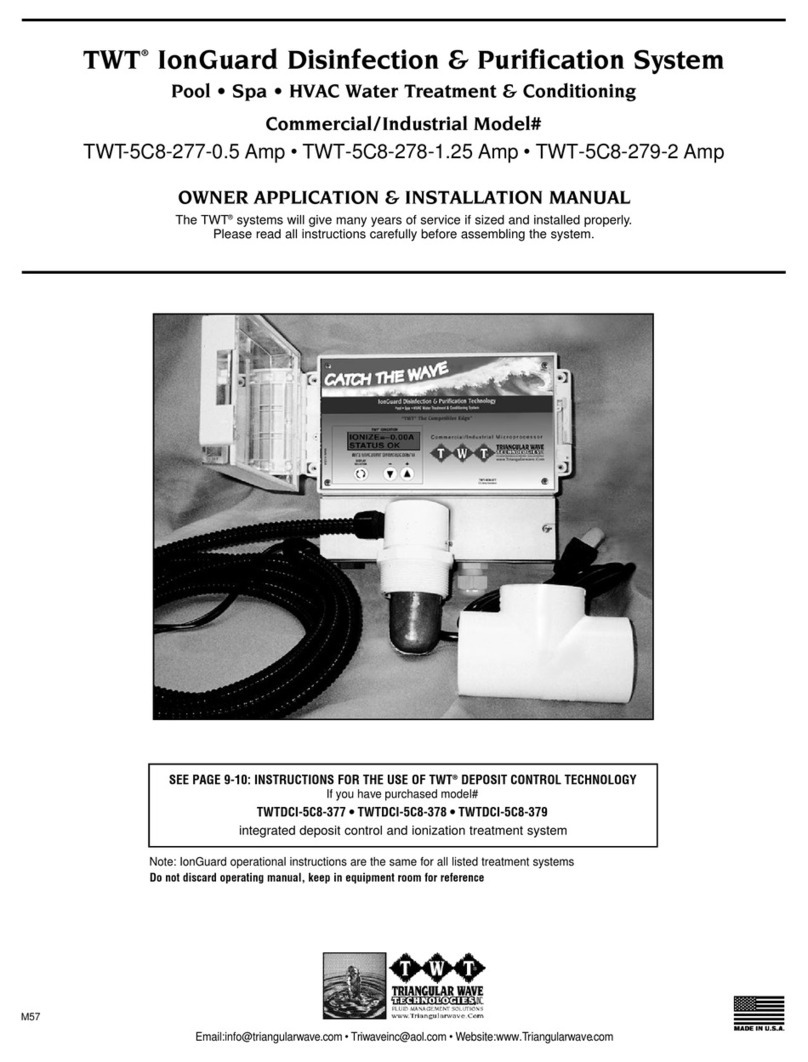
FACTORY ASSEMBLED WATER TREATMENT
SYSTEM OWNERS MANUAL
TWT-POUS-300 Point-of-Use (P.O.U)
Integrated Water Softening, Treatment and Conditioning System
Filtration • Water Softening • Patented Deposit Control Technology
Ideal for the Beverage (Coffee) Dispensing Industry
TWT-POUE-400 Point-of-Use (P.O.U) Point-of-Entry (POE)
Integrated Water Treatment and Conditioning System
Filtration • Patented Deposit Control Technology
Ideal for Cottages, Mobile Homes, RV’s, Boats & More.
System Design and Installation Guidelines
Please take the time and read the following suggestions before installation
M62
TWT®YOUR SIMPLE AND SAFE
SOLUTION
You have now purchased a technologically advanced
water treatment system that with proper mainte-
nance, will insure cleaner water for decades to
come. Providing end-to-end treatment and condi-
tioning with consistent results.
1. TWT-POUS-300 Application
The TWT Integrated system should be installed at
point-of-use, on or near the beverage dispensing
machines requiring treatment (for water-fed lines 3/4" in
diameter or less) . Select a location near water feed
line in an area allowing enough room on all sides of
system for filter(s) replacement, visual inspection,
keeping it out of harm’s way (i.e., appropriate service
clearances).depending upon model purchased.This
will allow most maintenance procedures to be accom-
plished without removing the unit and filters from its
mounting bracket.
2. TWT-POUE-400 Application
The TWT Integrated system should be installed at P.O.U./P.O.E., near water-fed
line (for water-fed lines 3/4" in diameter or less). Select a location near water
feed line in an area allowing enough room on all sides of system for filter(s)
replacement, visual inspection, keeping it out of harm’s way (i.e., appropriate ser-
vice clearances). This will allow most maintenance procedures to be accom-
plished without removing the unit and filters from its mounting bracket.
FILTRATION-
Traps & Removes Harmful Pollutants, prevents restriction and keeps
water in the plumbing system flowing
Filters are designed to trap various kinds of debris, dirt and organic particles
that will otherwise enter your equipment and/or plumbing system, restrict your
water flow and create a breeding ground for bacteria. The first step in achieving
clean water is to install a filtration
device that effectively removes particulate
matter and similar debris.
Filters used in TWT-POUS-300 system
1. Sediment 5-10 Micron: Pleated
Washable and reusable for sediment
reduction/removal
2. Resin Filter: Water softening resin filter
3. GAC: Granulated activated carbon for
taste, odor, organic chemicals and chlo-
rine reduction/removal.
Filters used in TWT-POUE-400 system
1. Sediment 5-10 Micron: Pleated Washable and reusable for sediment
reduction/removal
2. GAC: Granulated activated carbon for taste, odor, organic chemicals and
chlorine reduction / removal
3. GAC/KDF-55:
Granulated activated carbon with KDF-55, specially formulated
copper/zinc alloy media designed to remove chlorine, lead, volatile organic
chemicals,hydrogen sulfide, sulfur, herbicides, pesticides, chemical fertilizer
residues and trihalomethanes
Note: See maintenance calender
DEPOSIT CONTROL-
TWT®Patented Deposit Control Technology
The basic component in the TWT systems is
the deposit controller.It is comprised of a
microprocessor, solenoid coil factory wrapped
reaction chamber. The microprocessor is a
patented controller that functions like a comput-
er to relay a continuous electrical power sup-
ply to the solenoid coil reaction chamber. The
reaction chamber is part of the system, and
provides a factory wrapped wire coil forming a
solenoid. The solenoid conveys the triangular
wave signal at the appropriate power level
(as allowed by the model chosen) to the water
passing through the chamber. This signal con-
stantly changes the polarity, frequency, and
amplitude of the current entering the water.
This triangular wave treatment produces sever-
al benefits.It increases the capability of the water to hydrate scale
ions and other colloidal particles. In effect, the surface charge of
the hydrogen molecules is enhanced and the water is made “wetter”.
This“hydrated” water can dissolve unwanted
particles, suspend them in solution, and allow
them to be easily filtered out or flushed from the
system.Accordingly, the mineral and biological
particles that cause scale, deposits, and corro-
sion are dissolved and washed away.
This means that the breeding environments for
bacteria, such as bio-film and corrosion, are
eliminated.The agitation created in the reaction chamber also disrupts
the conditions essential for the normal reproduction of bacteria and they
die, thus allowing them to be harmlessly flushed out of the system.
FLOW METER-
Battery operated digital flow meter with ability
to reset so users may track total flow in gal-
lons. Offers ability to monitor multiple functions,
with capacity settings 100 to 19,900 gallons.
Audible alarm indicates cartridge/ media
replacement.
When the TWT systems are properly installed and
maintained, the effects of the Triangular Wave
Technology Treatment Last Downstream. In effect, a clean, corrosion-free
delivery systems restored and maintained in a safe manner. The result is
clean tanks, pipes and tubing with no bio-film and reduced bacterial
contamination.
TWT systems make sense from operational, economic, and safety points of
view. Ownership of the TWT System will afford you and/or your customers
significant savings over a short period of time and even greater savings over
the life cycle of the equipment.
All though simular in design, the TWT-POUS-300 (above) uses a
Sediment, Resin and Carbon filter. The TWT-POUE-400 uses a
Sediment, Carbon and GAC-KDF-55 Filter (1-2 GPM System)
System1.
System 2.
TWT Deposit Controller
























